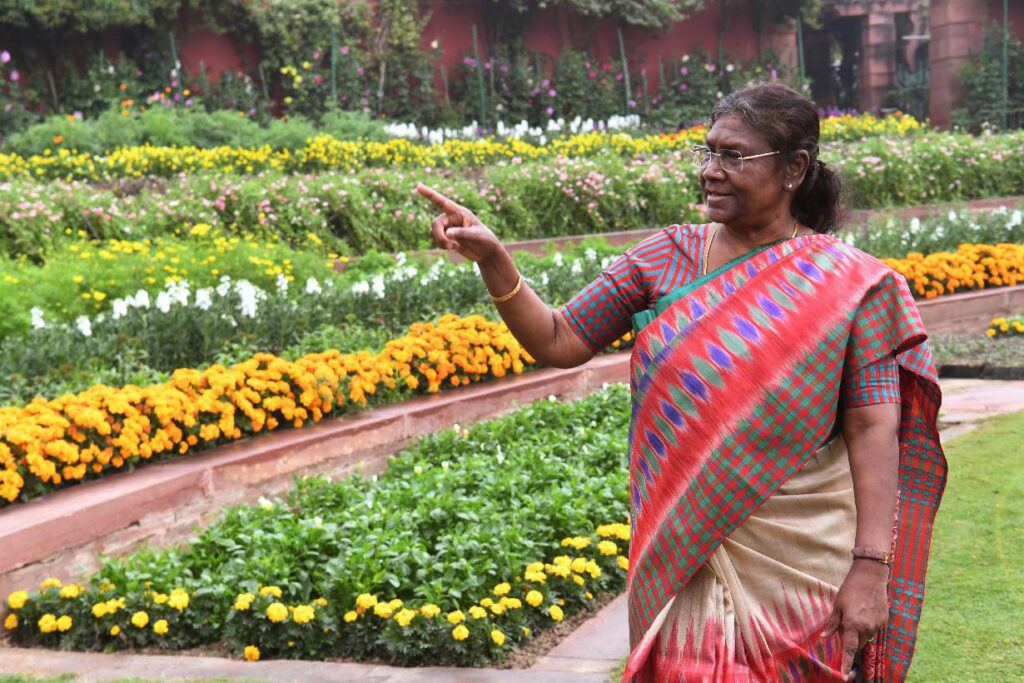
Travel:
Amrit Udyan: Garden of the Holy Nectar
Visiting the President’s Gardens at Rashtrapati Bhavan
Even as Spring finally materializes in New York, I share with you gorgeous sunlit photos from my recent visit to the beautiful gardens of the President’s home Rashtrapati Bhavan. Previously known as the Mughal Gardens, I have fond memories of visiting them many times with my siblings during my growing up years in Delhi. There was always a sense of pride in their beauty, and a sense of ownership – they were the people’s gardens.
What was special this year was that for the first time India has a president from the tribal community ( she is the second woman president in India – Pratibha Patil was the first) and Rashtrapati Bhavan is her home. Prebsident Droupadi Murmu renamed the gardens, which were created by the British in 1929, as ‘Amrit Udyan’ meaning ‘Garden of the Holy Nectar’. It is a matter of pride to think that she is the one who gets to see and enjoy these gardens first thing in the morning – maybe have a morning stroll or a cup of tea there. Every year these gardens are opened up to the people of India to enjoy and of course many state guests visit them from around the world too.
This year I was lucky enough to be there for the inaugural opening season of the gardens and when friends offered to take me with them, I jumped at the offer. Of course, after the cold dreary winter, thousands of other Indians had the same intention of visiting the gardens too. Fortunately the security was so well organized that thousands of people managed to have a good time relishing the beauty without getting in anyone’s way; there is a pride in this being the country’s gardens and you see long lines of children on school visits, getting to see the fruits of democracy.
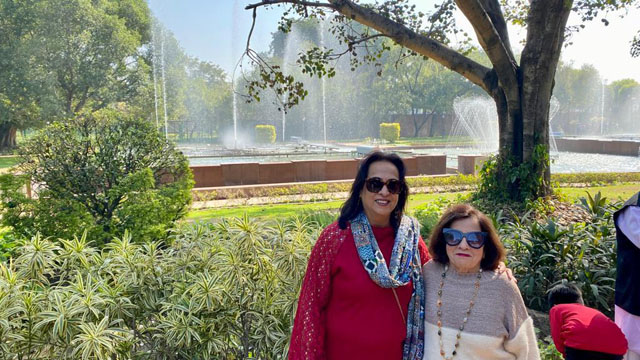
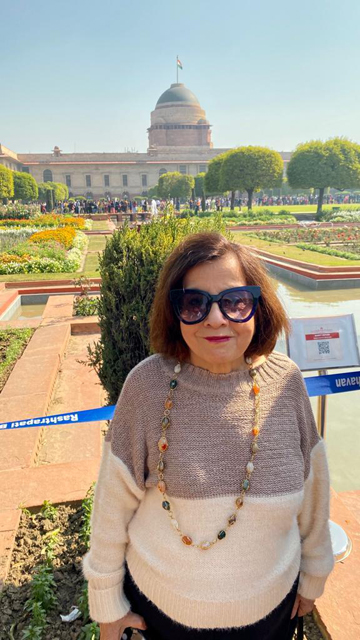
It was also in a way National Selfie Day because all around you saw families clicking pictures on their phones and it’s so easy to make selfie friends – shooting pictures for complete strangers, and have these return the favor for you! What did we ever do without our phone cameras!
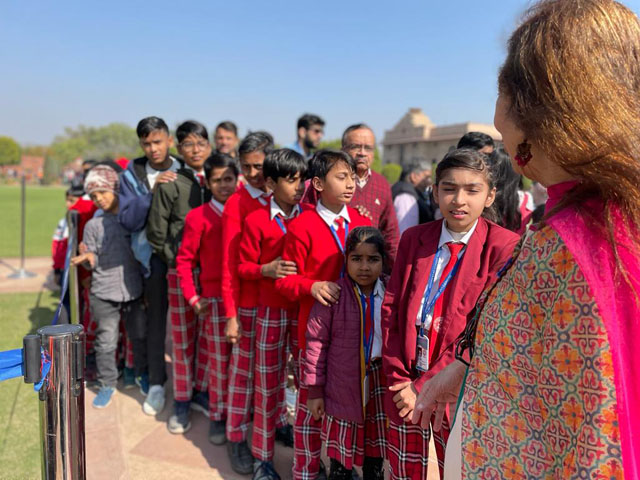
The president’s estate is set over 330 acres and includes parks, gardens, fruit trees and ponds. There’s even a 75 acre nature trail with a mango orchard, orangery, butterfly corner, peacock point and a forest ecosystem with 136 plant species and 84 animal species.
So what are the gardens really like? Rather than attempt to give you my un-expert opinion, I am sharing the scholarly text from the Rashtrapati Bhawan website so you have the most authentic details. Do explore it fully for you get to see all aspects of the President’s home as well as the handsome gardens which include Amrit Udyan, along with a Herbal Garden, a Spiritual Garden and a Musical Garden, each with their own fascinating text on which president initiated the changes at each of these gardens.
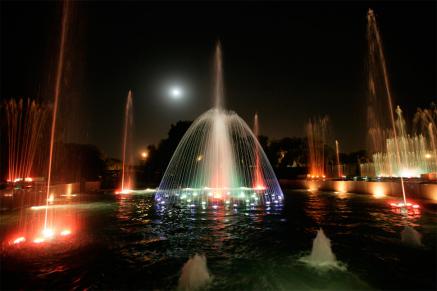
Enjoy! The full text is at https://rashtrapatisachivalaya.gov.in/rbtour/
Amrit Udyan – The Garden of the Holy Nectar
Two channels running North to South and two running East to West divide this garden into a grid of squares. There are six lotus shaped fountains at the crossings of these channels, whereas the energetic fountains rising upto a height of 12 feet create soothing murmur that enthralls visitor. The channels are so tranquil in their movement that they seem frozen. In the channels at appropriate times of day can be seen reflections of the imposing building and the proud flowers. There are wooden trays placed on stands in the center of the channels where grain is put for the birds to feed upon.
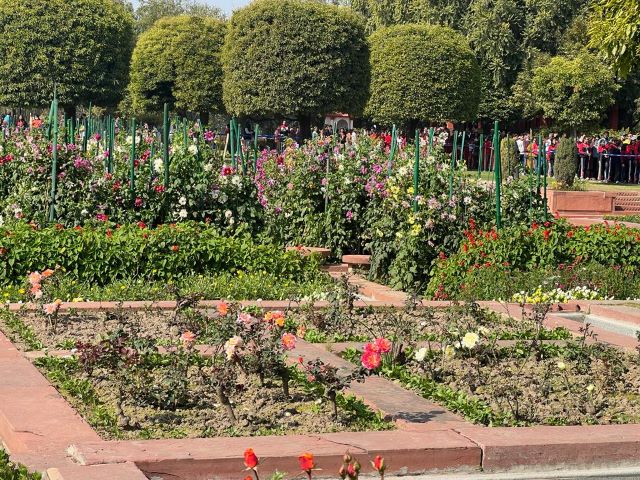
There are two big lawns; the central one is a square with each side being 45 meters and the East lawn adjacent to the building, oblong in shape and about three fourth the size of Central lawn. The lawns are covered by ‘Doob’ grass which was originally brought from Belvedere Estate, Calcutta when they were initially laid. The entire turf of the lawn is removed once in a year before the monsoons, new top soil is spread and it takes three weeks for the grass to grow again.
In the evenings peacocks with their consorts can be seen leisurely moving around. And once in a while a lapwing can be seen meditating oblivious of the surrounding splendour. Then there are Spotbills (Resident ducks of Delhi Region) who have made a home of the channels and the garden. They are often seen enjoying a family picnic what with gardeners in attendance with bread crumbs and choicest greens for their repast. And then there are parrots, mynahs, doves, pigeons that bath and bask with an ease of manner that evokes envy and admiration in all onlookers. Few lucky ones have also spotted birds like cormorant, jay or a transiting stork.
This garden derives its evergreen texture from Moulsri, Putranjiva Roxburgi, Cypress, Thuja Orientalis and China Orange trees, rose shrubs and a variety of climbers.
Moulsri or Bakul is a typically Indian tree. Planted in the square patches of lawns along the channels and on the periphery of the two main lawns, they are pruned to look like mushrooms. They provide character and depth to the garden. They flower in the months of May and June and their mild sweet fragrance saturates the surroundings. This tree has been mentioned in the ‘Sangam’ literature, in the plays of the great poet Kalidasa and more recently by Abul Fazl in Ain-in-Akbari. There is an interesting detail of this tree in a play by Kalidasa: The tree about to bear flowers is compared to a pregnant woman who nurtures desires for unusual things. Thus during the budding period the tree was said to have a desire to be sprinkled with mouthfuls of liquor by a virtuous maiden. This privilege was reserved for the queens and the princesses and celebrated in a royal ceremony.
Cypresses line the pavement and give a touch of formality, by virtue of their unchanging, full, erect shape. Planted axially they provide a perspective of depth. China Oranges alternate with Cypresses, and provide a welcome break from monotony. Whereas Cypress symbolises death and afterlife the China Oranges change their appearance through various stages of growth from season to season, symbolising renewal and celebration of life.
Putranjiva Roxburgi are planted around the two gazebos located at the western ends of the two terrace gardens. Not more than a skeletal structure of stone beams these gazebos are unique by themselves and in combination with the shade of Putrnajiva Roxburgi create an inviting grove of peace and repose.
Thuja Orientalis, a coniferous tree ornately hemmed in squares of well chiselled hedges of Golden Duranta presents a marvellous spectacle. This combination is placed along the periphery of the main garden and marks the various intersections and terminations in the pattern.
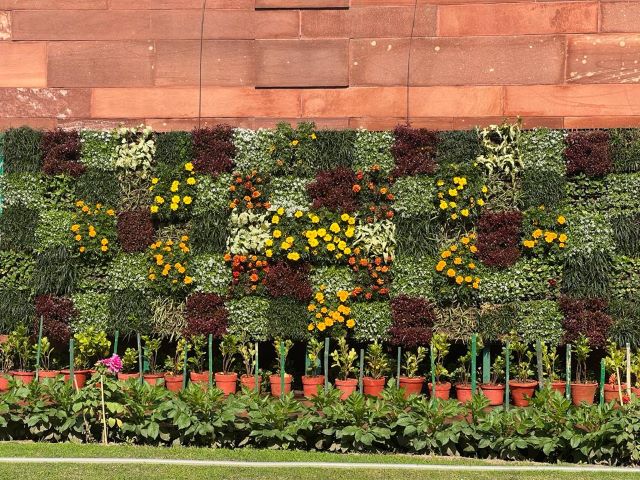
The following evergreen fragrant shrubs and creepers are planted along the terrace walls:
- Raat ki Rani
- Mogra
- Motiya
- Juhi
- Bignenia Vanista (Golden Showers)
- Gardenia
- Rhyncospermum
- Petrea
- Harshringar
- Bougainvillea
- Adenocalymma (Garlic Creeper)
- Hedera Helix
- Climbing Roses
- Tecoma Grandiflora
- The Rangoon Creeper
India’s Rose Garden
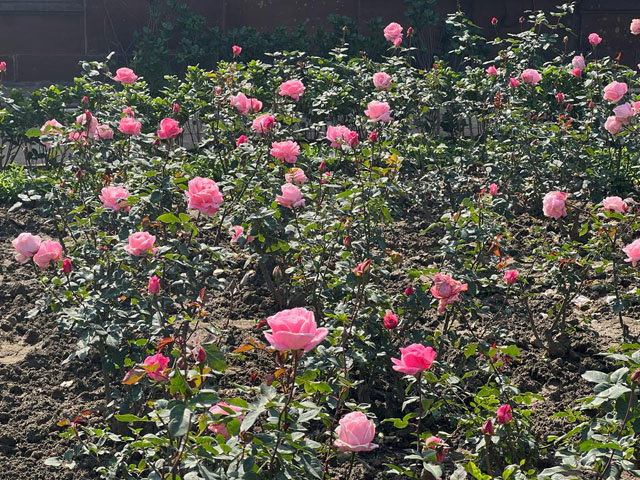
Roses flower throughout the year. The prime bloom though is after they are pruned in October every year. Along with the evergreens mentioned so far, roses help in achieving the permanence in texture throughout the year.
The garden has more than 250 celebrated varieties of roses, which makes it one of the best Rose Gardens in the world. It has roses like Bonne Nuit, Oklahoma which are neares to being black. In blues it has Paradise, Blue Moon, Lady X. We also have the rare green rose. The Roses ahve some very interesting names. Few Indians that have found place here are Mother Teresa, Arjun, Bhim, Raja Ram Mohan Roy, Jawahar, Dr.B.P.Pal. The international celebrities here are John F.Kennedy, Queen Elizabeth, Mr.Lincoln, Montezuma. Others worth mentioning are Christian Dior, Happiness, Century Two, First Prize, Jantar Mantar, Peter Frankenfeld, American Heritage, Bejazzo, Iceberg, Granada, World Rose, Command Performance, Imperator. The list is endless and the spectacle delightful.
Various herbaceous annuals and biennials are grown in beds and informal borders. The beds are sited at the edge of lawns or along the pavements. Also the flowers are massed irregularly with respect to their height and grouped in colour combinations to produce harmonious, natural and pleasing effect.
The planting of seasonals is done twice a year in preparation for the “At Homes” hosted by the President on the occasion of the Republic Day( 26th January) and the Independence Day(15th August) every year, which are hosted in the Central lawn.
For winters the garden is replete with a number of annuals that have to compete with each other to find a place. Dwarf annuals like Calendula, Antirrhinum, Alyssum, Dimorphotheca, Eschscholzia (Californian Poppy), Larkspur, Gaznia, Gerbera, Godetia, Linaria, Mesembryanthemum, Portulaca, Brachycome, Metucharia, Verbena, Viola, Pansy, Stock grow well in flower beds. Other annuals that are grown include Dahlia, Aster, Carnation, Chrysanthemum, Clarkia, Statice, Lupin, Marigold, Nicotinia, Nemesia, Bells of Ireland, Poppy, Stock, Salvia, Cosmos, Linum, Sweet Sultan, Sweet Pea, Cineraria, Sweet William etc. They are used in pure beds and in combinations of varying heights create a pyramid of colours.
Edging and bordering of flower beds is done by Alyssum, Phlox, Petunia, Dasy, Pansy, Mimulus etc. Under the standard roses are grown Daisies, Mesembryanthemum, Pansies, and Viola. Naturalizing effect is created by the bulbous flowering plants like Narcissus, Freesia, Zephyranthrus, Gladiola, Tuberos, Oriental Lily, Asiatic Lily, Tulips, Anemone, Ranunculus, Iris, Daffodils etc.
If You Want to Visit Amrit Udyan
(There is no charge for visiting the gardens of Rashtrapati Bhavan during Udyan Ustav, but you will need to book a slot beforehand. Bookings can be made online at the President of India website or at visitor registration kiosks on the spot. Online booking slots open 10 days in advance from the date of visit. )
